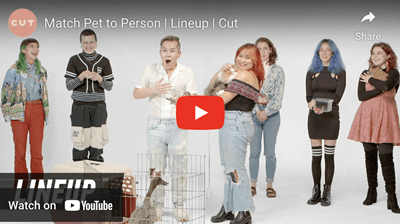How many times have you taken your dog outside for a walk, only to find them dragging along a new stick to add to their collection? If your dog is like many others, they love playing and chewing on sticks. Learn about your dog’s stick fascination and how healthy of a habit your dog’s stick collection truly is!
In the article below, Dr. Jess explains the common reasons why dogs love sticks and what medical concerns to worry about if your dog is a stick lover.
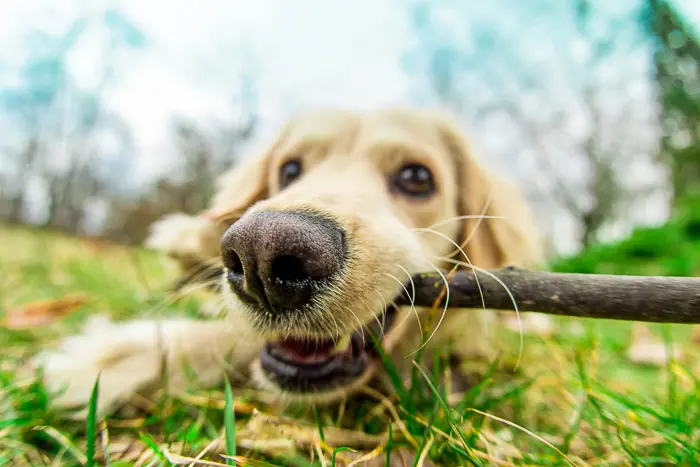
What Do Dogs Eat? The Canine Diet:
Some dogs aren’t too picky about what they eat. They’ll eat whatever you try to give them.
Some dogs are pickier than others. Pickier puppies can be hard to properly feed.
A common pet canine diet consists of a complete dry or wet feed and possibly supplements in some specific cases (not all pet dogs need supplements).
There is also foraging if the dogs are allowed to roam or are feral, and of course there are treats!
The diet of every dog breed can very and is important to know when offering food to your dog.
An improper diet could put your dog at risk of having problems properly digesting their food and absorbing nutrients correctly. And we don't want that now do we???
An improper diet can also include human foods. Find out if things like okra, tuna, mayo, and fish are healthy and safe for your dog to eat!
So let's talk specifically about sticks and how it could affect your dog's diet and overall health.
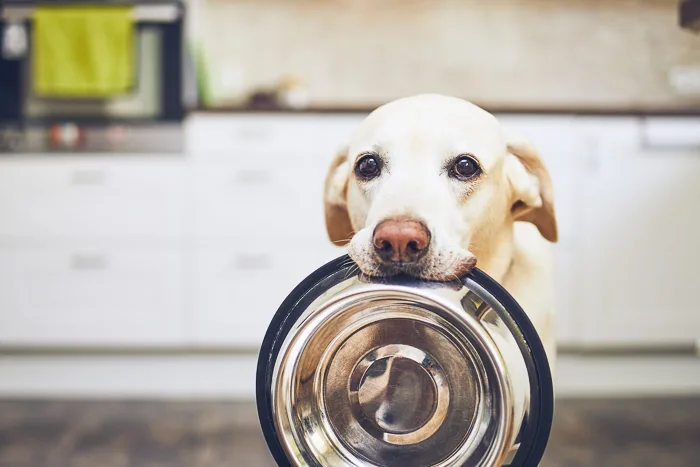
Why Do Dogs Like Sticks?
I have come up with the 8 most common reasons why your dog may be picking up that stick in the park. Your pup may be choosing a stick over your ball for one of these reasons below.
1. The Obvious: Toys Are FUN!
Toys are fun and meant to chase, catch, chew, toss, kill, and tear apart.
Sticks are great toys in the eyes of your dog because they can chew on them for hours.
Toys are fun and engaging way for your dog to work off pent-up energy and feel more like a dog.
2. The History: Natural Instincts of Hunter / Forager:
The hunting instinct of most dogs is strong, even in our domesticated dogs, from chihuahuas to great danes.
The stick that Fluffy picked up at the park may give them the opportunity to harness this inner hunter or forager instinct.
They may even show it off and want you to be very impressed with their hunting and gathering skills – it is best to play along and act impressed.
They may hunt down this stick, fetching the target. Once the ‘prey’ has been captured, it will need be ‘killed’ and torn apart.
Be careful of this part of the act. Tearing apart a stick can have major consequences which are discussed further down in this article.
3. Bone Shape:
We can all imagine that sticks resemble the shape of long bones in the eyes of our carnivorous (meat-eating) canine companions.
Dogs love bones for their texture, but even more so for the flavor of the meat attached the bone as well as the delicious and nutritious bone marrow hidden inside the long bones.
A wooden stick is a great substitute when chewing or gnawing on a bone is not an option.
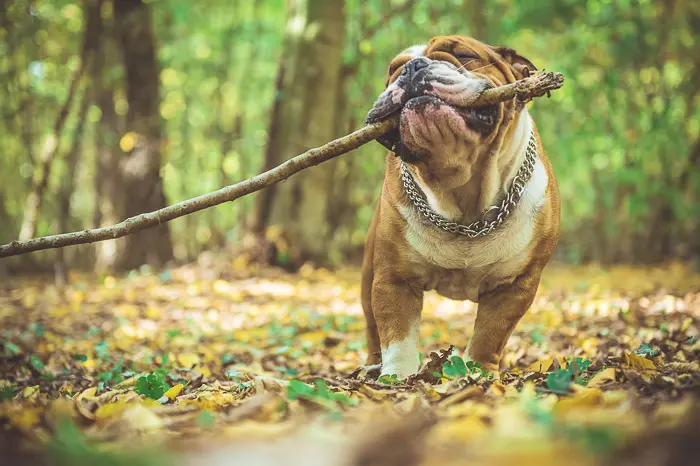
4. Taste and Texture:
Dogs can tell that there is a difference in taste and texture between a stick and a bone. However, sticks have their own appeal – their earthy, musky taste that seems to appeal to most dogs.
Taste is not the only appealing thing about sticking that stick in your dog’s mouth. The texture of a stick is also a part of its appeal.
From fresh, soft, supple green twigs to dry, crunchy, crumbly sticks that they fall apart as soon as you pick them up, the range of textures that can be found in sticks is fun to test when you’re a dog on the prowl.
5. Bones Smell Good:
As most people know, dogs have a fantastic sense of smell. This excellent sense of smell will entice your dog to sniff, lick, and taste anything which smells appealing, including sticks and sometimes even rocks and dirt.
Your dog can pick up all of kinds of smells from a stick, even ones that you or I could never smell. Not only may your dog pick up a stick because it smells delicious or interesting, but they may also pick it up to transfer the scent on to others.
6. Mouth Play:
Mouth exploration and the drive to hold things in the mouth to learn more about them is common to all dogs.
Some dogs are more likely to carry sticks around than others.
If your dogs like to constantly have things in their mouth to roll around and play with, then they may be a dog that fits in this category.
7. Teething or Sore Gums:
A teething puppy or a dog that has sore gums or any one of the many tooth issues dogs are prone to, will likely have a increased desire to chew on things, and may be much more likely than other dogs to want to chew on sticks.
Chewing is also a natural stress reliever for most all dogs.
8. Potential Nutritional Deficiencies:
Some people believe that dogs and other animals will eat things that they shouldn’t, also known as pica, like dirt, feces, or other organic matter like sticks, because they are nutritionally deficient in some way.
How Do Sticks Injure Dogs?
Dogs typically receive stick-related injuries in two different ways – through chewing and ingesting the stick or a piece of it, or by chasing or running with the stick (think of it like a child running with a pair of scissors!).
Stick-chasing injuries are usually more severe and intense injuries than the stick-chewing injuries, but any stick injury, if not treated quickly and properly by a trusted veterinarian, can become a major health issue very quickly.
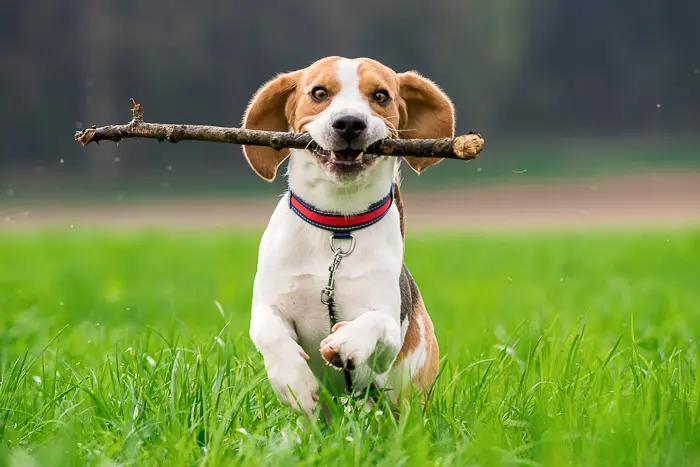
Medical Concerns of Dogs Having Sticks:
Most dogs are smart enough to chew and spit stick pieces out as they chew. However, there are some dogs that swallow pieces of their sticks, which can cause problems. Then there are other dogs who accidentally swallow a stick that they know they shouldn't.
There are a multitude of problems that could arise from ingestion of stick pieces, running with sticks, or even chewing the wrong type of stick.
Here is a list of the more common medical issues regarding dogs and their beloved sticks, starting from the head, and working our way down the dog's body:
- Punctures or splinters in the dog's gums, tongue, or esophagus
- Punctures of the roof of a dog's mouth (hard or soft palate), or further down the throat in such areas as the pharynx
- Wood that is inhaled into the trachea can lead to possible obstruction (blockage), irritation, and/or infection of the respiratory tract. These can also lead to chest infections, upper or lower respiratory infections, or damage to the heart, nerves, and/or blood vessels.
- Stick fragments that are swallowed down the esophagus and into the lower parts of the digestive tract, which can result in digestive tract irritation, bleeding, and possible obstruction (also known as a blockage, or a “foreign body”). This may require abdominal exploratory surgery to remove the “foreign body”.
- Toxicity from a toxic stick
- Ingestion of parasite, fungus, or other pathogen from chewing on an infested stick
- Impalement in a dog's eye, mouth, face, or
- Penetration of a dog's chest, which can result in damage to their heart and/or lungs depending on the area of impalement. These can also lead to chest infections, upper or lower respiratory infections, or damage to the heart, nerves, and/or blood vessels.
Stick Toxicity:
Sticks from certain fruit trees such as apple, pear, and other fruit trees can be an issue, because the wood from these trees is pretty tasty to many dogs.
These trees can be toxic and can give your dog quite an upset stomach.
There are other trees, such as Azaleas, black walnut, black cherry, red oak, black locust, red maple, and yew trees that can also be toxic to your pet.
Lastly, all living creatures, dogs and humans alike, can experience food allergies. There is a potential, just like any other food, for your dog to have an allergic reaction to okra.
This means even if your dog has been fine with some foods before, that won’t always be the case.
Common symptoms of food allergies in dogs include recurring skin problems and gastrointestinal issues that can result in decreased energy, lack of appetite, or diarrhea and/or vomiting.
Stick Size Concerns:
Size does matter with some things, and sometimes, the size of the stick does matter.
Small Sticks:
Smaller sticks have an unfunny way of getting stuck in small and large places where they don’t belong, which can become dangerous for your pup. If your dog likes to shred sticks into even smaller sticks, make sure that they are not attempting to swallow them. That could lead to some big issues that I discussed above!
Big Sticks:
Big sticks can quickly turn into lots of splinters or smaller sticks, which can get lodged or stuck pretty much anywhere.
Branches and larger sticks are most typically the culprit in stick impalement injuries that I've seen too. No running and frolicking with a big stick in your dog’s mouth!
I haven’t seen this with my own eyes, but have heard from other veterinarians, of an instance or two of dogs with their jaws locked open because a large stick got wedged inside.
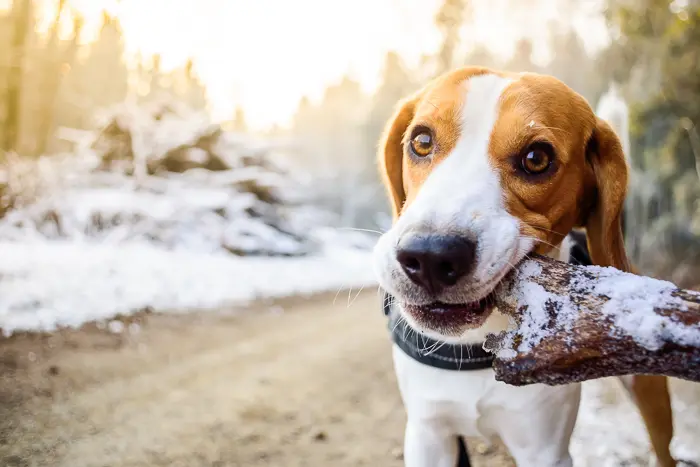
Further Medical Complications:
Not only do you need to worry about all of these types of issues with sticks, but sticks can cause more issues down the road.
Wood is Tricky:
The initial tissue damage caused by a penetrated stick isn’t always the full extent of a dog’s injuries. Veterinarians worry about a bit more than just the initial stick problem.
It’s not uncommon for smaller fragments of the initial piece of wood to be missed during your pet’s initial surgical exploration of their puncture wounds.
This happened to one of my personal horses back before I went to vet school – and $15,000 later and a year without leaving his “room”, he could start therapy!
This was not and is not due to a lack of skills by the veterinary team. It is because wooden foreign bodies tend to shatter and splinter upon impact, and once wet (due to blood), can flake off into the surrounding tissues and hide and become infected.
Wood also tends to have a hard time showing up on radiographs (X-rays), and the smaller the wood pieces, the harder and harder it gets to visualize once inside the body. There is always going to be the possibility for further surgeries down the road if any residual wood pieces have shown up.
Secondary Infections:
As with any foreign body, there is also the risk of infection if the foreign particles have been floating around inside the body for any length of time, giving bacteria the time they need to grow and spread.
Dog Stick Alternatives:
If you supply your dog with lots of other safe and engaging toys to play with, they wont even notice the missing sticks from the yard.
After removing sticks from your premises, be certain to replace the sticks with plenty of toys and chew bones to replace the sticks and to keep your dog entertained, both physically and mentally.
Providing safe-chewing alternatives is a major key to breaking your dog’s stick-chewing and chasing habit!

![[Vet Explains Pets]](https://vetexplainspets.com/wp-content/uploads/2024/09/cropped-vetlogo-199x66.png)
